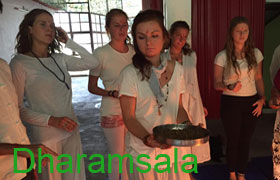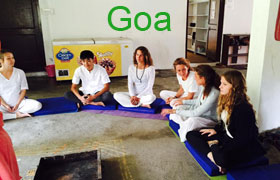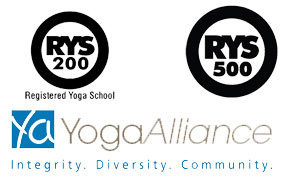Yoga Nidra
Click Below for audio Instructions For Yoga Nidra
 Yoga Nidra in sanskrit means yogic sleep. It is a powerful technique introduced by Tantra Yoga tradition. It is not only the name of a practice but it is also the name of a state. Lord Krishna is often mentioned to be residing in this state. In the latest era Swami Satyananda Saraswati is known to have experienced this amazing state. Yoga nidra is an intermediate state between sleeping state and full consciousness. A person completely loses the awareness when he sleeps. But the person in the state of yoga nidra would stay highly conscious though his body is in a deep relaxation mode. Though yoga nidra finds its origin in Tantric yoga, it can be classified as a part of the ashtanga yoga. Almost three limbs of ashtanga yoga constitute yoga nidra.
Yoga Nidra in sanskrit means yogic sleep. It is a powerful technique introduced by Tantra Yoga tradition. It is not only the name of a practice but it is also the name of a state. Lord Krishna is often mentioned to be residing in this state. In the latest era Swami Satyananda Saraswati is known to have experienced this amazing state. Yoga nidra is an intermediate state between sleeping state and full consciousness. A person completely loses the awareness when he sleeps. But the person in the state of yoga nidra would stay highly conscious though his body is in a deep relaxation mode. Though yoga nidra finds its origin in Tantric yoga, it can be classified as a part of the ashtanga yoga. Almost three limbs of ashtanga yoga constitute yoga nidra.
1. Pranayama: Specialized exercises involving breathing techniques which would eventually enable the practiser to control his breath and prana (life energy force).
2. Dharana: Concentration on one’s own self for perceptual awareness of his inner self
3. Pratyahara: Extending control over sensory organs that fascinate the mind through worldly pleasures which do not serve any purpose on the path to salvation and moreover turn out to be hurdles.
Main aspects of yoga nidra
1. It is a systematic method of total relaxation at physical, mental and emotional levels while still maintaining deep levels total consciousness.
2. It can enable an individual to manifest his physical, mental and spiritual desires.
3. It aids in the path of liberation.
Benefits
Yoga nidra can impart excellent benefits on and off the mat. Adding up a session of yoga nidra at the end of any sequence of asanas would prove to be extremely relaxing and refreshing. It can be extremely helpful in preparing your body and mind for the practice of meditation. Today’s lifestyle subjects every person to a high level of stress and frustration which dissipates negative impulse into their lives. Yoga nidra is the highly efficient method to handle such stress and frustration. A systematic practice of yoga nidra can relieve mental, physical and emotional tensions. Yoga nidra can actually tame your mind by boosting up your will power. It can train your mind to focus on your objectives to mould them into your achievements. It is an excellent means to relax, refresh and retreat your mind, body and soul. It can effectively expunge any kind of phobias blocked at the unconscious level. As yoga nidra works at deep levels of conscious, sub conscious and unconscious mind, the mind is completely at peace and exhibits highest level of creativity. It improves the memory and learning capabilities of an individual. It is extremely efficient in managing psychological disorders and psychosomatic diseases.
Precautions
1. Though yoga nidra is so simple that it can be practiced at anytime and anywhere, it is better not to choose post lunch timing as you may end up only sleeping without yoga.
2. You may feel cold at the end of a yoga nidra sessions as it generally tends to drop the temperature of your body. Thus it is good idea to use a blanket while practicing yoga nidra.
3. The place chosen for yoga nidra should be peaceful and calm without any disturbances.
4. You should be able allot ample amount for yoga nidra as you cannot practice it under deadlines as they impose pressure by nature.
5. As the practice of yoga nidra would require you to lie down, you should lie down in very relaxed posture. If you feel any pain in your lower back you may use a pillow under your knees. You may also use a thin pillow under your head to feel comfortable. However take care that your comfort zone does not end you up in sleep mode.
Procedure
1. Lie down straight on your back on the floor in the posture if shavasana.
2. Close your eyes and relax yourself taking deep breaths in and out.
3. We shall contemplate each and every part from head to toe deeply relaxing by moving our concentration on to every part.
4. We shall start it with our right toe. Bring the entire concentration of your mind on to your right toe and contemplate it entering into a deep mode of relaxation.
5. Now gently move your attention on to your ankle and visualize it being relaxed in the similar fashion.
6. Now move on your attention on your knee and feel it deeply relaxed. Repeat this process of contemplation through every part of your right leg and feel it entering a deep mode of relaxation.
7. Feeling the awareness of your right being deeply relaxed move on your concentration to your left leg and continue contemplate. When you are done with your both of your legs, extend your visualization of relaxation on to your stomach, navel, chest, hands, shoulders, throat and head.
8. Enjoy each of this part transiting into a very deep relaxation state with complete awareness.
9. Bring your concentration to the area amidst your eyebrows. Concentrate for a couple of minutes in this area.
10. Move your attention to the center of your throat and concentrate over it for another couple of minutes.
11. Move your concentration into the center of your chest and then into the center of your heart. Empty your awareness completely of all the thoughts, perceptions and visualizations. Feel the void inside you. Just stay still and silent.
12. If you get disturbed by any thought at this stage, simply ignore and continue your process of contemplation without feeling guilty. This process needs a lot of practice to experience the state of complete emptiness.
13. You can stay in this state of stillness for 10 minutes in the beginning. This time period can be increases with practice.
14. With consistent practice you may attain a state of total emptiness with the highest level of awareness. This will enable you to experience the state of divine bliss in further stages of meditation.
15. Continue this process as long as you can.
16. Now gradually feel the consciousness of your body and your surroundings. Turn to your right side and continue to lie down for some more time.
17. When you feel comfortable you can sit up and open your eyes slowly.
The yoga teacher training in India provided by our Yoga Faculty is the best choice to learn the process of yoga nidra.




